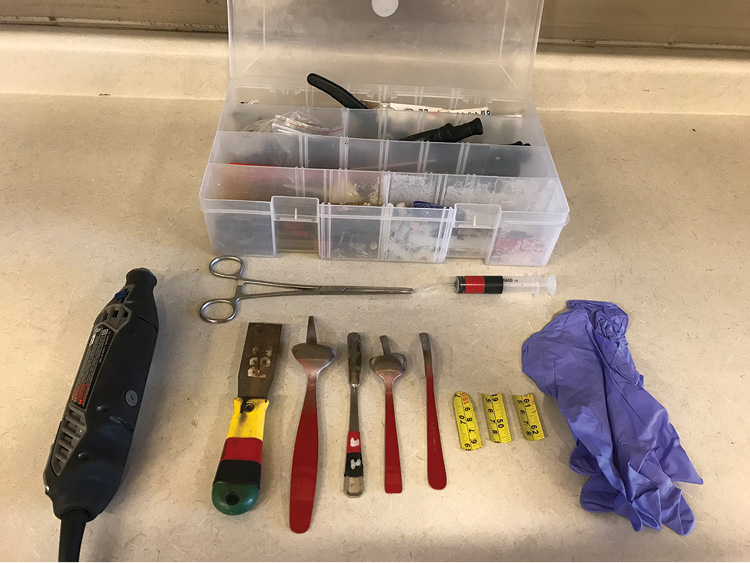
By Andrew Brassard
“How did they get stuck in that?” In my entire firefighting career, I have asked this question often. I am still amazed by the objects in which hands, fingers, toes, feet, and other appendages become entrapped, requiring firefighters to delicately remove the objects with saws or other specialized tools. Whether we respond to assist the local hospital staff or someone in need walks into our fire station, we may have to remove anything from rings to a children’s toy. Preparing for such extrications requires that fire departments have the proper tools and equipment prior to such an incident. Many departments have a specialized tool kit or a machinery rescue kit on their apparatus that is dedicated to these more delicate and detailed rescue operations.

(1) Photos by Chris Burke.
Machinery Rescue Kit Essentials
You can carry the machinery rescue kit in a sturdy hard plastic tool case or a large canvas tool bag. The hard plastic case will withstand the rigors of riding on the apparatus and placement on whatever ground surface you’ll encounter. You can also use canvas tool bags, but they are less resistant to wear and tear over time. One essential item to include in the kit is a rotary cutting tool; it is extremely valuable for many extrications. Its small-diameter cutting blades, variable speeds, and ease of use are invaluable.
To keep the rotary cutting tool’s various small blades, attachments, and bits in easy reach, keep them in a separate container inside the kit. With some units, the smaller containers may be marked to designate the material the blades are designed to cut, such as steel, wood, and glass.
Other valuable tools for a machinery rescue kit are hard protection safety tools, which provide a protective barrier between what you are cutting and the trapped person’s skin.
Store these items in a small clear plastic tackle box such as that used for fishing lures. This allows you to customize the storage spaces to accommodate the different types of hard protection.

(2)
Among the many everyday items you can use for hard protection are thinned-out spoons, butter knives, putty knives, and tape measure sections (photo 1). A section of an old tape measure can be used as hard protection (photo 2). Many rescue unit kits include numerous tool types, sizes, and shapes appropriate to the patient’s size and the material you are cutting.
Other vital pieces of equipment to include in the kit are extra safety glasses, medical gloves, markers or other writing utensils for marking your cuts, water, lubricant, and lubricant syringes to apply the lubricant and coolant to the material being cut. Lubricants can range from ordinary dish soap to various types of oils (vegetable, motor, and cutting fluid). The tools and equipment you carry in your kit will depend on the target hazards within certain industries in your response area or on previous rescue experiences.
Size-Up
As with any extrication, perform a good size-up and progress from the easy removal method to the more difficult, time-consuming solution if needed. Cutting an object off a person should not necessarily be your Plan A. First, see if you can remove the entrapment using lubricant; if not, you might need to make a cutting plan.
Described below are three extrications to which our department responded in the past year that required our machinery rescue tool kit.
Ring Removal
On a cool fall day, Milton (Ontario, Canada) Fire Department (MFD) Station 3’s night tour had just begun when dispatch received a call from the local hospital requesting the department’s response to the emergency room to assist doctors in removing a ring from a person’s finger. Pumper 31 (a rescue/engine) responded and a nurse escorted members to the room where the patient was waiting. The captain went into the room to size up the situation and evaluate the patient’s physical and mental status and determine what would need to be done for the extrication as the crew set up the tools and equipment. The size-up revealed that the victim had two rings on her ring finger that needed to come off immediately because of severe swelling and blood flow restriction (photo 3).

(3)
The doctors were concerned about the blood flow restriction and the amount of time the finger had been suffering this ailment. The captain ordered the use of the rotary cutting tool to remove the two rings; using a hand-operated ring cutter would take longer, and time wasn’t on the rescuers’ side. Also, because of the extreme swelling, the ring cutter’s bottom jaw would not fit under the rings.
Hard protection is normally inserted between the finger and the object to be removed, but in this case the swelling was so significant we could not insert even a single section of tape measure between the rings and the finger. A putty knife and thinned-out screwdriver were inserted between the top and the bottom of the rings as far as we could get them in, which was not very far. Even so, this created a small separation between the rings and the patient’s finger so one ring could be cut at a time. The firefighter operating the tool had to be very meticulous in performing a delicate cutting operation to avoid cutting the patient with the high-speed rotary blade.
Remember, whenever you are cutting metal that is touching the patient’s skin, you must perform aggressive cooling to prevent the metal from heating up and burning the patient’s skin. Also, knowing the type of metal you are cutting is important; the harder the metal, the more quickly it will heat up. To easily cool the metal you are cutting, use an automotive lubricant syringe or a squirt bottle, both of which are inexpensive and easy to carry in the machinery kit. It is also very important for the firefighters performing the extrication to wear eye protection. Also, provide eye and other appropriate protection for your patient and the others in the room (medical staff and the patient’s family).
As we started cutting, we made sure that the patient was not looking at the tool and her finger as we performed the operation. We didn’t want the patient to flinch or to move her hand as we were cutting. Also, another member was positioned to hold the victim’s hand and to separate the fingers to allow the firefighter using the rotary tool better access to the area and to avoid coming in contact with the patient’s skin.
At first, we operated the tool at a slow speed to get an initial purchase and then increased to medium speed throughout the entire cutting process. In addition, we performed aggressive cooling the entire time; we had backup bottles of water standing by so we could quickly swap out containers when one became low. We also frequently stopped to ensure the patient’s comfort and allow the rings to cool down.
Once we carefully cut the rings all the way through, we used a pair of snap ring pliers (used to remove snap ring attachment washers) to spread the ring off the finger. Using a large pair of snap ring pliers, you can place one arm of the pliers on one side of the ring and place the other arm on the opposite side of the ring and then spread the ring off the finger (photo 4).

(4)
When dealing with rings made of hardened metal such as titanium, this may not be possible and a second cut on the opposite side of the ring may be needed. Whenever using snap ring pliers to perform a ring expansion, use caution because the pliers may slip off the ring and onto the patient.
After we removed the rings, the extreme swelling of the patient’s finger was evident. Surprisingly, the patient felt no relief to her finger after the rings were removed; in fact, she said that the pain and pressure in her finger were the same. We started to use the lubricant syringe and some cotton swabs to irrigate the space under the rings, which was full of metal shavings, often a common by-product of this type of extrication. Closer inspection revealed that it appeared that there was something still inside the folds of the skin underneath the tremendous amount of swelling. An extremely small rubber band was found under the folds of the swelling, to everyone’s amazement (photos 5-6). We used tweezers to hold the rubber band, which we cut with medical scissors. The rubber band was from a pair of orthodontic braces. The woman said she often put the rubber bands on her fingers while putting them on her braces in her mouth. One slid down her finger without her noticing and became wedged under her rings. When she awoke the next morning, the band had been cutting off the circulation to the end of her finger all night. After the ring and rubber band were removed, the swelling in her finger immediately started to go down and she made a full recovery.
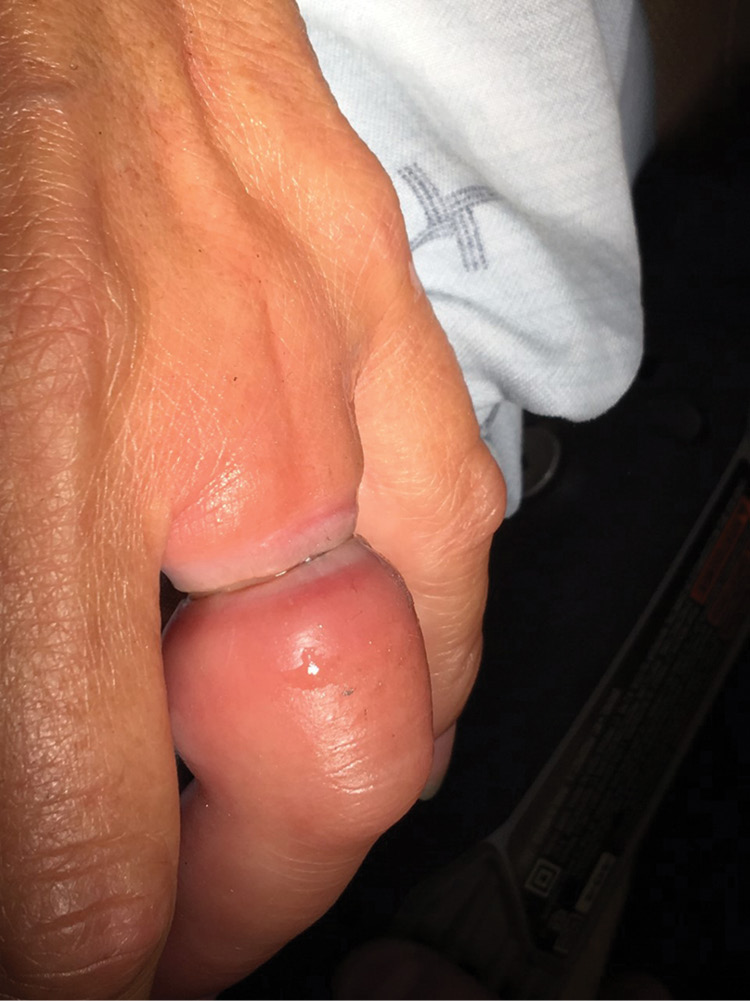
(5)
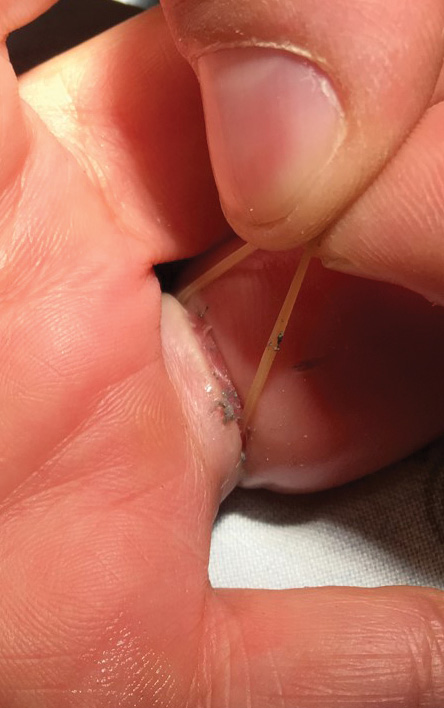
(6)
Coffeemaker Removal
On a beautiful summer day, MFD Station 3 staff were performing station duties when there was a knock at the fire station door. Again, they were met with an unusual rescue extrication. A mother had brought her 10-year-old son, who’d managed to get his finger stuck in an espresso machine part, to the station (photo 7). After making several attempts at home to remove the finger from the metal and plastic cylinder, the mother decided to bring her son to the fire station once the swelling became more severe. The child was brought into the station and was made comfortable as the firefighters sized up the situation. Knowing it might involve using the machinery rescue tools, members were already retrieving the kit. Meanwhile, other members attempted to use lubricant to remove the object, unsuccessfully. Cutting was determined as the best course of action, and we formulated a plan. Prior to starting the cutting operation, we showed the mother and the child the tools we were going to use and how we were going to use them, to put the mother and child at ease.
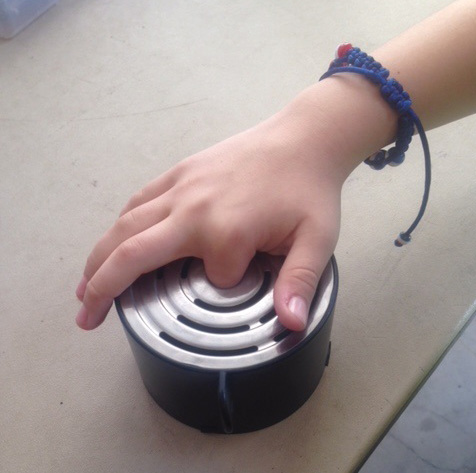
(7)

(8)

(9)
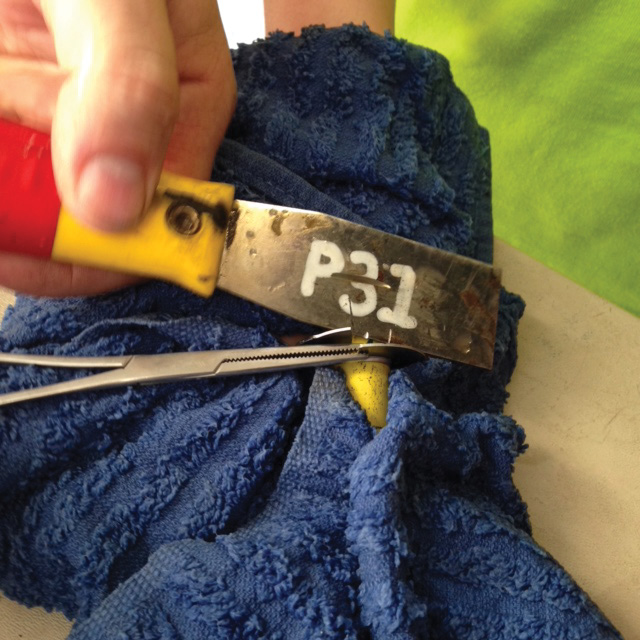
(10)
The cutting plan formulated was to reduce the metal piece entrapping the finger down to the size of a large washer by making two cuts in the face plate of the cylinder. The child and the mother were given safety glasses to ensure their eye protection. We placed sections of tape measure between the finger and the metal canister as hard protection. Stacking up several sections of tape measure will create a very good layer of protection from the cutting tool. To protect the child’s hand, we also used a putty knife in case the saw blade broke or the saw “caught’’ and moved unexpectedly.
As you can see, the top of the canister is made up of a series of rings that are joined at small connection points; we decided as part of the cutting plan to cut the two innermost connection points to reduce the canister down to a single washer-sized piece of metal on the child’s finger. As the first cut began, the child said he did not like the feel of the sparks hitting his hand, so we used a blanket to wrap the hand for protection. We used forceps to keep the metal disk stable while cutting (photos 8-10).
Once we cut the ring through one side, we used two pairs of pliers to bend the metal ring to the offset position, which allowed the child to remove his finger from the metal disk.
Incident 3
My volunteer department, the Centre Wellington Fire Department Station 40, also responded to the local hospital to assist doctors with the extrication of a child’s toy from his finger. Volunteer firefighters responded to the call in Heavy Rescue 45 along with Car 2 (a deputy chief). On arrival, Car 2 took command and, after a quick and thorough size-up, instructed members to bring the rotary tool kit into the emergency room. The five-year-old child had managed to get his finger stuck in the connector hole for a set of wooden train tracks (photo 11).
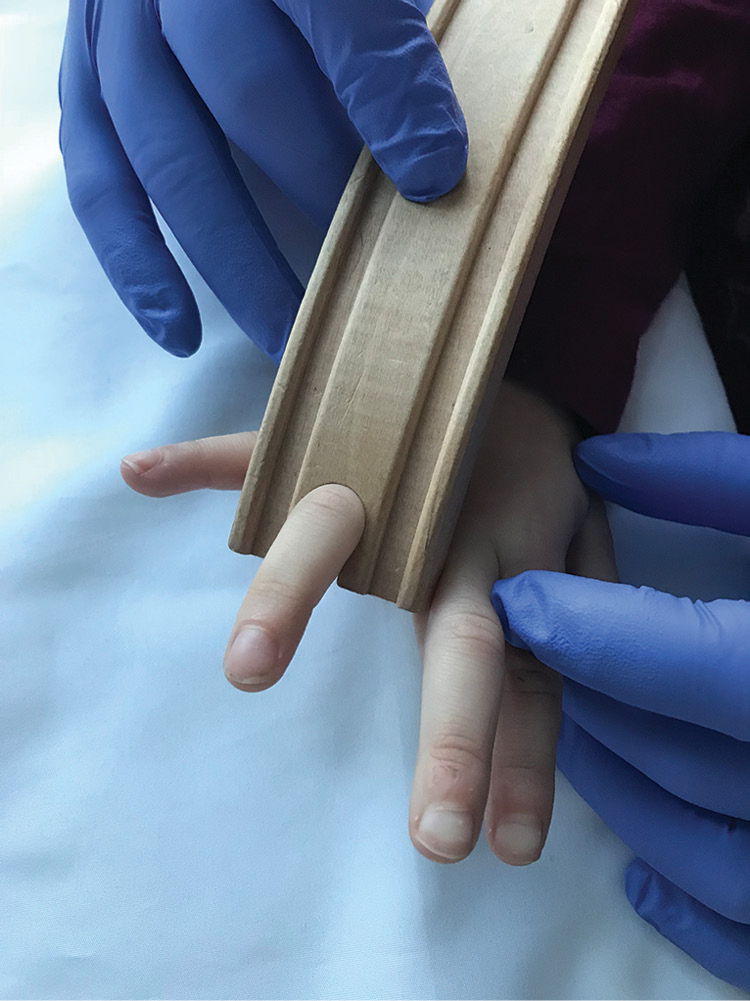
(11)
The child was in good spirits but was extremely nervous. Shortly after the fire department’s arrival, the child’s mother arrived, which was extremely comforting for the child. Doctors informed our members that the track needed to come off as soon as possible because of the swelling and because circulation to the child’s finger was being cut off. As in all operations, we placed eye protection on the child and on the nurse who was stabilizing his hand and blocking his view of the cutting process.
The swelling was so severe that members could not place hard protection between the child’s finger and the track. It was determined not to be an issue because the cutting plan was to make a small relief cut farther down toward the bottom of the hole in the wood; this way, once cut, the flexible track could be bent, enlarging the hole’s diameter and freeing the child’s finger.
We operated the rotary cutting tool at medium speed using a wood cutting blade. We monitored the heat level of the track near the cut; since it wasn’t being heated, no water was used to cool the material. Once the cuts were made, we inserted a small spreader tool (used to remove casts off arms) into the connector hole opening, which spread to create enough room for the child to remove his finger (photo 12).
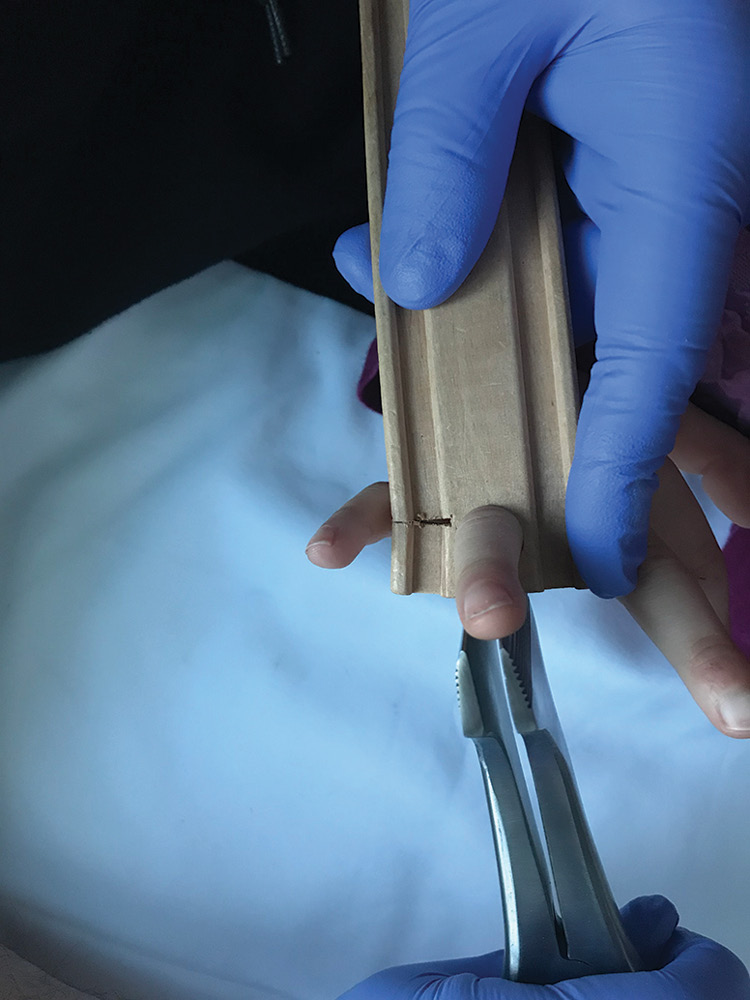
(12)
Lessons Learned and Reinforced
- When performing these types of intricate extrications, take your time since they often are not life-or-death calls. Take your time and do it right!
- Your members should wear eye protection as should your patient. Include a few extra pairs of eye protection in your machinery extrication kit.
- These are specialized calls that require specialized tools and training, so ensure your department has both.
- Hard protection is a vital tool for these extrications. Make sure you have a wide range of sizes and thicknesses to accommodate various sizes of fingers and appendages.
- Using a rotary tool for fine cutting is a special skill that needs frequent practice to hone.
- Aggressive cooling is a must! Ensure that the material you are cutting remains cool; it is among the most frequently forgotten aspects of these extrications.
- Practice cutting a variety of materials, from metal to wood and everything in between. You never know in what material someone will become entrapped.
- Always ensure that the patient cannot see the cutting operation; this will limit the natural reaction for the patient to flinch.
- Start with the simplest solution and work your way up to the harder and more time-consuming solution.
- Building a rapport with patients is important; their trust in you is vital in keeping them still during the extrication operation.
- Showing young children the tools you are using first will go a long way in keeping them calm.
- Distracting children while performing these extrications can be useful. Try using a cell phone or an iPad with their favorite TV show on to shift their focus from the extrication.
- Anesthetic is not recommended. When performing these extrications at a hospital, nurses sometimes will want to use lidocaine for numbing the affected area. This is not a great idea, since you want the patient to be able to feel the material in which they are entrapped and communicate whether it is being heated and causing discomfort.
- Ring cutters are great to include in your kit, but they may not cut all rings. Lots of rings now are made of more hardened metals that traditional ring cutters may not be able to cut.
- If the cutting sparks are impinging on the towels or other materials around, wetting the blankets is a great option.
Sizing up entrapment materials, selecting the correct blade that will cut the material best, placing hard protection, and having the ability to safely cut different materials that are very close to your patient are extremely perishable skills. You must practice them frequently; like any skills, if you don’t use them, you will lose them. Ensure you practice these skills often in realistic situations. That way, the next time someone knocks on the fire station door with an appendage caught in whatever you can imagine, you will be ready.
Andrew Brassard is a career firefighter with the Milton (Ontario, Canada) Fire Department and is a volunteer firefighter with the Centre Wellington Fire Department Station 40. He is an instructor with RSRescue and with Take the Door Training in Syracuse, New York. Brassard has taught at numerous conferences in Canada and the United States.

